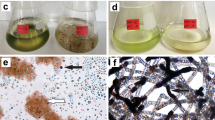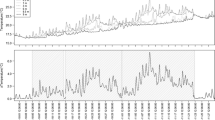Abstract
The redox processes regulating transport of Mn in the water column of a eutrophic, dimictic lake (Lake Norrviken, Sweden) are interpreted based on a one-dimensional diffusion-reaction model for Mn(II). It is found that rates and rate constants for oxidation and reduction vary greatly with depth and also with time during the season of stratification. Calculated rates show that Mn(II) oxidation and reduction generally occur in narrow depth intervals (25–50 cm). This is in good agreement with measured profiles of particulate Mn (MnO x ). Maximum oxidation rate constants (assuming first order kinetics) at each date are in the first half of the season <1 d−1, but then increases to a rather constant value of about 25 d−1. These high rate constants are indicative of microbiological involvement in the Mn(II) oxidation. This is further evidenced by SEM-EDS analysis showing Mn enriched particles morphologically similar toMetallogenium. Reductive dissolution of Mn oxides occurs mainly in the zone just below the zone of maximum oxidation rate. The release of Mn(II) is accompanied by production of alkalinity and ΣCO2. The relation between production rates of Mn(II) and alkalinity indicates that Mn oxides act as terminal electron acceptors in the bacterially mediated oxidation of organic matter. However, the ΔMn2+/ΔΣCO2 ratio is significantly lower than what is expected from this process. It is suggested that the Mn reduction is coupled to fermentation. Close coexistence of Mn reduction and oxidation at high rates, such as found in the water column of this lake, facilitates rapid and continuous regeneration of reducible Mn oxides. This gives rise to a quantitatively important mechanism of organic matter oxidation in the water column.
Similar content being viewed by others
References
Adams L.F. and Ghiorse W.C. (1987) Characterization of extracellular Mn2+-oxidizing activity and isolation of an Mn2+-oxidizing protein fromLeptothrix discophora SS-1.J. Bacteriol. 169, 1279–1285.
Aguilar C. and Nealson K.H. (1994) Manganese reduction in Oneida Lake, New York: Estimates of spatial and temporal manganese flux.Can. J. Fish. Aquat. Sci. 51, 185–196.
Ahlgren I. (1967) Limnological studies of Lake Norrviken, a eutrophicated Swedish lake.Schweiz. Z. Hydrol. 29, 53–90.
Ahlgren I. (1978) Response of Lake Norrviken to reduced nutrient loading.Verh. Internat. Verein. Limnol. 20, 846–850.
Ahlgren I., Sörensen F., Waara T. and Vrede K. (1994) Nitrogen budgets in relation to microbial transformations in lakes.Ambio 23, 367–377.
Balistrieri L.S., Murray J.W. and Paul B. (1994) The geochemical cycling of trace elements in a biogenic meromictic lake.Geochim. Cosmochim. Acta 58, 3993–4008.
Burdige D.J. and Gieskes J.M. (1983) A pore water/solid phase diagenetic model for manganese in marine sediments.Amer. J. Sci. 283, 29–47.
Burdige D.J. and Nealson K.H. (1986) Chemical and microbiological studies of sulfide-mediated manganese reduction.Geomicrobiol. J. 4, 361–387.
Burdige D.J., Dhakar S.P. and Nealson K.H. (1992) Effects of managanese oxide mineralogy on microbial and chemical manganese reduction.Geomicrobiol. J. 10, 27–48.
Calvert S.A., Karlin R.E., Toolin L.J., Donahue D.J., Southon J.R. and Vogel, J.S. (1991) Low organic carbon accumulation rates in Black Sea sediments.Nature 350, 692–695.
Canfield D.E. (1993) Organic matter oxidation in marine sediments. InInteractions of C, N, P and S Biogeochemical Cycles and Global Change (eds. Wollast R., Mackenzie F.T. and Chou L.), pp. 333–363. Springer-Verlag, Berlin/Heidelberg.
Carignan R. and Lean D.R.S. (1991) Regeneration of dissolved substances in a seasonally anoxic lake: The relative importance of processes occuring in water column and in the sediments.Limnol. Oceanogr. 36, 683–707.
Chapnick S.D., Moore W.S. and Nealson K.H. (1982) Microbially mediated manganese oxidation in a freshwater lake.Limnol. Oceanogr. 27, 1004–1014.
Cline J.D. (1969) Spectrophotometric determination of hydrogen sulfide in natural waters.Limnol. Oceanogr. 14, 454–458.
Colberg P.J. (1988) Anaerbic microbial degradation of cellulose, lignin, oligolignols, and monoaromatic lignin derivatives. InBiology of Anaerobic Microorganisms (ed. Zehnder A.J.B.), chap. 7, pp. 333–372, Wiley-Interscience.
Davies S.H.R. and Morgan J.J. (1989) Manganese (II) oxidation kinetics on metal oxide surfaces.J. Coll. Interf. Sci. 129, 63–77.
Davison W., Woof C. and Rigg E (1982) The dynamics of iron and manganese in a seasonally anoxic lake; direct measurement of fluxes using sediment traps.Limnol. Oceanogr. 27, 987–1003.
De Vitre R.R., Buffle J., Perret D. and Baudat R. (1988) A study of iron and manganese transformations at the O2/S(-II) transition layer in a eutrophic lake (Lake Bret, Switzerland): A multimethod approach.Geochim. Cosmochim. Acta 52, 1601–1613.
Diem D. and Stumm W. (1984) Is dissolved Mn2+ being oxidized by O2 in the absence of bacteria or surface catalysts?Geochim. Cosmochim. Acta 48, 1571–1573.
Dubinina G.A. (1978) Functional role of bivalent iron and manganese oxidation inLeptothrix pseudoochracea.Mikrobiologiya 47, 783–789.
Ehrlich H.L. (1980) Different forms of microbial manganese oxidation and reduction and their environmental significance. InBiogeochemistry of Ancient and Modern Environments. (eds. P.A. Trudinger et al.), pp. 327–332 Aust. Acad. Sci.
Emerson D., Garen R.E. and Ghiorse W.C. (1989) Formation ofMetallogenium-like structures by a manganese-oxidizing fungus.Arch. Microbiol. 151, 223–231.
Emerson S., Kalhorn S, Jacobs L., Tebo B.M., Nealson K.H. and Rosson R.A. (1982) Environmental oxidation rate of manganese(II): bacterial catalysis.Geochim. Cosmochim. Acta 46, 1073–1079.
Forelich P.N., Klinkhammer G.P., Bender M.L., Luedtke N.A., Heath G.R., Cullen D., Dauphin P., Hammond D., Hartman B. and Maynard V. (1979) Early oxidation of organic matter in pelagic sediments of the eastern equatorial Atlantic: suboxic diagenesis.Geochim. Cosmochim. Acta 43, 1075–1090.
Giovanoli R., Brütsch R., Diem D., Osman-Sigg G. and Sigg L. (1980) The composition of settling particles in Lake Zürich.Schweiz. Z. Hydrol. 42, 89–100.
Handbook of Chemistry and Physics, 55th edn. (1974) CRC Press.
Imboden D.M., Eid B.S.F., Joller T., Schurter M. and Wetzel J. (1979) MELIMEX, an experimental heavy metal pollution study: Vertical mixing in a large limno-corral.Schweiz. Z. Hydrol. 41, 177–189.
Ingri N., Kakolowicz L.G., Sillén L.G. and Warnquist B. (1967)Talanta 14, 1261.
Jassby A. and Powell T. (1975) Vertical patterns of eddy diffusion during stratification in Castle Lake, California.Limnol. Oceanogr. 20, 530–543.
Jellison R. and Melack J.M. (1993) Meromixis in hypersaline Mono Lake, California. 1. Stratification and vertical mixing during the onset, persistence, and breakdown of meromixis.Limnol. Oceanogr. 38, 1008–1019.
Johnson C.A., Ulrich M. Sigg L. and Imboden D.M. (1991) A mathematical model of the manganese cycle in a seasonally anoxic lake.Limnol. Oceanogr. 36, 1415–1426.
Jung W.K. and Schweisfurth R. (1979) Manganese oxidation by an intracellular protein of aPseudomonas species.Z. Allgem. Mikrobiol. 19, 107–115.
Klaveness D. (1977) Morphology, distribution and significance of the manganese-accumulating microorganism Metallogenium in lakes.Hydrobiol. 56, 25–33.
Kostka J.E., Luther III G.W. and Nealson K.H. (1995) Chemical and biological reduction of Mn(III)-pyrophosphate complexes: Potential importance of dissolved Mn(III) as an environmental oxidant.Geochim. Cosmochim. Acta 59, 885–894.
Likens G.E. and Johnson N.M. (1969) Measurement and analysis of the annual heat budget for the sediments in two Wisconsin lakes.Limnol. Oceanogr. 14, 115–135.
Lee C. (1992) Controls on organic carbon preservation: The use of stratified water bodies to compare intrinsic rates of decomposition in oxic and anoxic systems.Geochim. Cosmochim. Acta 56, 3323–3335.
Lesht D. and Bauman Jr J.E. (1978) Thermodynamics of the manganese(II) bicarbonate system.Inorg. Chem. 17, 3332–3334.
Lim D.V. (1989)Microbiology. West Publishing Company.
Lovley D.R., Phillips E.J.P. and Lonergan D.J. (1989) Hydrogen and formate oxidation coupled to dissimilatory reduction of iron or manganese byAlteromonas putrefaciens.Appl. Envir. Microbiol. 55, 700–706.
Lovley D.R. (1991) Dissimilatory Fe(III) and Mn(IV) reduction.Microbiol. Rev. 55, 259–287.
Luther G.W., Nuzzio D.B. and Wu J. (1994) Speciation of manganese in Chesapeake Bay waters by voltametric methods.Anal. Chim. Acta 284, 473–480.
McNichol A.P., Lee C. and Druffel E.R.M. (1988) Carbon cycling in coastal sediments: 1. A quantitative estimate of the remineralization of organic carbon in the sediments of Buzzards Bay, MA.Geochim. Cosmochim. Acta 52, 1531–1543.
Millero F.J. (1986) The thermodynamics and kinetics of the hydrogen sulfide system in natural waters.Mar. Chem. 18, 121–147.
Miyajima T. (1992a) Biological manganese oxidation in a lake I: Occurrence and distribution ofMetallogenium sp. and its kinetic properties.Arch. Hydrobiol. 124, 317–335.
Miyajima T. (1992b) Production ofMetallogenium-like particles by heterotrophic manganese-oxidizing bacteria collected from a lake.Arch. Microbiol. 158, 100–106.
Moffett J.W. (1994) The relationship between cerium and manganese oxidation in the marine environment.Limnol. Oceanogr. 39, 1309–1318.
Murphy J. and Riley J.P. (1962) A modified single solution method for the determination of phosphate in natural waters.Anal. Chim. Acta 27, 31–36.
Myers C.R., and Nealson K.H. (1988) Bacterial manganese reduction and growth with manganese oxide as the sole electron acceptor.Science 240, 319–321.
Nealson K.H., Tebo B.M. and Rosson, R.A. (1988) Occurrence and mechanisms of microbial oxidation of manganese.Adv. Appl. Microbiol. 33, 279–318.
Nealson K.H. Myers, C.R. and Wimpee B.B. (1991) Isolation and identification of manganese-reducing bacteria and estimates of microbial Mn(IV)-reducing potential in the Black Sea.Deep-Sea Res. 38, S907-S920.
Nordstrom D.K., Plummer N.L., Langmuir D., Busenberg E., May H.M. Jones B.F. and Parkhurst D.L. (1990) Revised chemical equilibrium data for major water-mineral reactions and their limitations. InChemical Modelling of Aqueous Systems II (eds. Melchior D.C. and Bassett R.L.), chap. 31, pp. 398–413. ACS Symposium Series 416.
Plummer L.N. and Busenberg E. (1982) The solubilities of calcite, aragonite and vaterite, and an evaluation of the aqueous model for the system CaCO3-CO2-H2O.Geochim. Cosmochim. Acta 46, 1011–1040.
Quay P.D., Broecker W.S., Hesslein R.H. and Schindler D.W. (1980) Vertical diffusion rates determined by tritium tracer experiments in the thermocline and hypolimnion of two lakes.Limnol. Oceanogr. 25, 201–218.
Rabouille C. and Gaillard J.F. (1991) Towards the EDGE: Early diagenetic global explanation. A model depicting the early diagenesis of organic matter, O2, NO3, Mn, and PO4.Geochim. Cosmochim. Acta 55, 2511–2525.
Skyring G.W. (1987) Sulfate reduction in coastal ecosystems.Geomicrobiol. J. 5, 295–374.
Stauffer R.E. and Armstrong D.E. (1984) Lake mixing and its relationship to epilimnetic phosphorus in Shagawa Lake, Minnesota.Can. J. Fish. Aquat. Sci. 41, 57–69.
Stone A.T. (1987) Microbial metabolites and the reductive dissolution of manganese oxides: Oxalate and pyruvate.Geochim. Cosmochim. Acta 51, 919–925.
Sunda W.G. and Huntsman S.A. (1987) Microbial oxidation of manganese in a North Carolina estuary.Limnol. Oceanogr. 32, 552–564.
Tebo B.M. (1991) Manganese(II) oxidation in the suboxic zone of the Black Sea.Deep-Sea Res. 38, S883-S905.
Thamdrup B., Glud R.N. and Hansen J.W. (1994a) Manganese oxidation and in situ fluxes from a coastal sediment.Geochim. Cosmochim. Acta 58, 2563–2570.
Thamdrup B., Fossing H. and Jørgensen B.B. (1994b) Manganese, iron and sulfur cycling in a coastal sediment, Aarhus Bay, Denmark.Geochim. Cosmochim. Acta 58, 5115–5129.
Tipping E. (1984) Temperature dependence of Mn(II) oxidation in lakewaters: a test of biological involvement.Geochim. Cosmochim. Acta 48, 1353–1356.
Tipping E., Thompson D.W. and Davison W. (1984) Oxidation products of Mn(II) in lake waters.Chem. Geol. 44, 359–383.
Wu H. and Scranton M.I. (1994) Cycling of some low molecular weight volatile fatty acids in a permanently anoxic estuarine basin.Mar. Chem. 47, 97–113.
Yao W. and Millero F.J. (1993) The rate of sulfide oxidation by δMnO2 in sewater.Geochim. Cosmochim. Acta 57, 3359–3365.
Zavarzin G.A. (1981) The genusMetallogenium. InThe Procaryotes: a handbook on habitats, isolation, and identification of bacteria (eds. Starr M.P., Stolp H., Truper H.G., Balows A. and Schlegel H.G.) chap. 43, pp. 524–528. Springer-Verlag, Berlin/Heidelberg/New York.
Zhang J.-Z. and Millero F.J. (1993) The products from the oxidation of H2S in seawater.Geochim. Cosmochim. Acta 57, 1705–1718.
Author information
Authors and Affiliations
Rights and permissions
About this article
Cite this article
Sternbeck, J. Manganese cycling in a eutrophic lake — Rates and pathways. Aquat Geochem 1, 399–426 (1995). https://doi.org/10.1007/BF00702741
Received:
Revised:
Issue Date:
DOI: https://doi.org/10.1007/BF00702741




